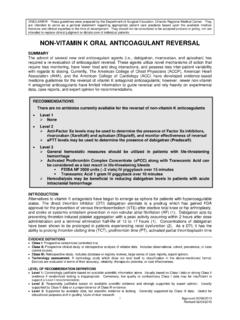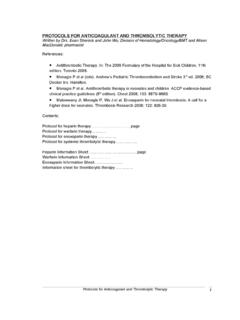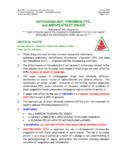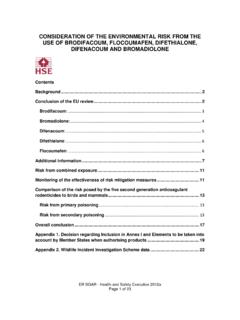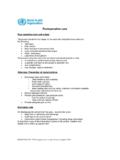Transcription of ENVIRONMENTAL RISK MITIGATION MEASURES FOR SECOND ...
1 ENVIRONMENTAL RISK MITIGATION MEASURES FOR SECOND generation anticoagulant rodenticides proposed BY THE UK Contents 1. 2. Aims and 3. Risk MITIGATION Restriction of user Restriction of outdoor situation of Option 1 - Restrict SGAR use to indoors (including sewers)..7 Option 2 - Restrict SGAR use to in and around buildings and Option 3 Restrict SGAR use to in and around buildings and sewers for professional users, and indoor use for non-professional Option 4 - Continue with the use areas/restrictions applied under Option 5 For professional users continue the use areas/restrictions from COPR, for non-professional users restrict all SGARs to indoor Proposal for authorising SGARs to treat rodent populations in specific restricted outdoor Restriction of bait formulation type and method of bait Bait formulation Use of bait stations and covered/protected bait Use of burrow Restriction of maximum duration of Specifying frequency of visiting bait 4.
2 Conclusions and proposed way forward for product authorisation under Restriction of user Restriction of outdoor situation of Restriction of bait formulation type and method of bait Restriction of maximum duration of Frequency of revisiting bait 5. Determining 6. 7. 22 Appendix 1. Approval and use of rodenticide products in Great Britain: experience under Appendix 2. Professional use of rodenticides in Great Britain: experience under Total bait used indoors and outdoors was 349,170 kg (Garthwaite, de'Ath & Thomas, 1999).26 Appendix 3. Alternative rodenticide active substances to Appendix 4. Summary of Wildlife Incident Investigation Scheme (WIIS) data on Appendix 5. Information on ENVIRONMENTAL exposure scenarios provided in the PT 14 Emission Scenario Document (EU, 2003)..30 ERMM SGAR - Health and Safety Executive 2012b Page 1 of 30 ENVIRONMENTAL Risk MITIGATION MEASURES for SECOND generation anticoagulant rodenticides proposed by the UK - Stakeholder engagement - August 2012 ERMM SGAR - Health and Safety Executive 2012b 1.
3 Background anticoagulant rodenticides form the mainstay of chemical control of rodents within the EU. Under the EU Biocidal Products Directive (BPD) five SECOND generation anticoagulant rodenticide (SGARs) active substances (brodifacoum, bromadiolone, difenacoum, difethialone and flocoumafen ) have recently been reviewed under the EU review programme. For each of these 5 SGAR active substances, it was agreed that they should be included on the Annex I "positive list", despite risks identified to humans, non-target animals and the environment, because of the public health benefits of their use and the lack of alternatives which are equally effective and carry less risk to the environment and humans. The final decision regarding how and where SGARs could be used within individual EU Member States was delegated to the Member States themselves. It was agreed that: "Member States will be able to make restrictions at the product authorisation stage on the use of rodenticides containing any of the 2nd generation anticoagulants, which can go further than the risk MITIGATION MEASURES explicitly set out in Annex I of Directive 98/8/EC.
4 Such MEASURES could include specific restrictions on outdoor use, or even a ban on such use, if such restrictions appear appropriate for sound scientific reasons." As UK Competent Authority for biocides, HSE has carried out a risk assessment for the ENVIRONMENTAL effects of the five SGARs based on the Annex I risk assessments from the EU reviews (which considered use in and around buildings (EU, 2012)) and on data collected by the UK. This assessment (see accompanying document: HSE, 2012a) led to the following conclusions: Data on the SGAR active substances indicate that brodifacoum is the most persistent in the environment and has the highest innate toxicity to birds and mammals; difethialone and flocoumafen have a higher innate toxicity than either bromadiolone or difenacoum; All of the PEC/PNEC ratios1 for primary2 poisoning are greater than one, indicating unacceptable levels of risk, however it is not possible to rank the five SGARs in terms of risk; All of the PEC/PNEC ratios for secondary3 poisoning are greater than one, indicating unacceptable levels of risk, however it is not possible to rank the five SGARs in terms of risk.
5 With regard to the secondary poisoning risk to birds, predator feeding studies have been submitted which indicate that, depending on the feeding profile, all SGARs can cause mortality and sub-lethal effects. However, these risks were not considered quantitatively in the EU reviews. Luttik et al (1999) reviewed several of the studies and stated that little can be deduced from these feeding studies about the relative toxicity of the compounds to barn owls, even when they are included in the same experiment ; 1 PEC = predicted ENVIRONMENTAL concentration; PNEC = predicted no effect concentration. If the resulting ratio is greater than 1 then further refinement or risk MITIGATION are required to ensure that the risk is acceptable . 2 Primary poisoning in this instance refers to the consumption of the bait itself. 3 Secondary poisoning in this instance refers to the consumption of treated rats, mice and other rodents by predatory or scavenging birds and mammals.
6 Page 2 of 30 ENVIRONMENTAL Risk MITIGATION MEASURES for SECOND generation anticoagulant rodenticides proposed by the UK - Stakeholder engagement - August 2012 ERMM SGAR - Health and Safety Executive 2012b Limited UK data on the use of flocoumafen and brodifacoum outdoors are available (Appendix 5), which indicate that incidents of poisoning of non-target organisms can occur. In 1987, the UK's independent Advisory Committee on Pesticides (ACP) recommended that the use of products containing these active substances should be limited to indoor use only (ACP, 1987) under our national biocides and pesticides legislation, the Control of Pesticides Regulations (COPR). No equivalent data are available for either difethialone, bromadiolone or difenacoum; Data from the UK's Predatory Bird Monitoring Scheme (PBMS) indicate residues of the SGARs are found in a wide range of species, as well as in a large proportion of predatory birds.
7 The source of the residues is unknown and the toxicological significance of the residues is not fully understood; Data from the UK's Wildlife Incident Investigation Scheme (WIIS) indicate that incidents involving four out of the five SGARs do occur4. The identified causes of these incidents range from correct use, abuse and misuse, whilst the causes of other incidents have not been identified. See Appendix 4 for further consideration of WIIS data. There are also concerns regarding under-reporting (Luttik et al, 1999; EFSA, 2009); The accompanying UK ENVIRONMENTAL risk assessment (HSE, 2012a) concluded that as the PEC/PNEC ratios for use in and around buildings are greater than 1 on the basis of the available data, no safe use can be identified for products containing SECOND generation anticoagulant active substances. However, as PEC/PNEC ratios only provide an indication of whether the exposure can exceed the no effect concentration , they should not be interpreted as meaning that all of the active substances pose the same risk in terms of likelihood and frequency of impacts.
8 In order to rank these active substances in terms of potential impact, further information is necessary, for example on the metabolism of the active substance, excretion rates and binding strengths, as well as ecological data on predatory/scavenging birds and mammals. Field trial data would also be needed to provide an indication of whether the predicted risks are realised under field conditions and the likelihood and frequency of impacts. It is not proposed to request such information, however, in the absence of these data, it is not possible to accurately rank these active substances in terms of potential risk. In view of the need to control infestations of commensal rodents for public health and the protection of infrastructure, and the importance of having efficacious rodenticides to achieve this, it is recognised that options might need to be considered which provide less than the maximum protection for non-target species and the environment, particularly where there are concerns for public health.
9 As the PEC/PNEC ratios are greater than one for all of the SGAR active substances, it is necessary to consider the role of risk MITIGATION MEASURES and in particular the likely impact they will have on reducing the risks. 2. Aims and outcome This document and the associated document (HSE, 2012a) discuss the risk of accidental poisoning of non-target wildlife by SGARs, the ENVIRONMENTAL risk MITIGATION MEASURES identified in the EU risk MITIGATION document (EU, 2007) and the effect they have on reducing ENVIRONMENTAL risks. They propose a number of ways forward which the UK could 4 No incidents have been reported for difethialone; as products containing this active substance have only been authorised in the UK since 2011, and for indoor use only. Page 3 of 30 ENVIRONMENTAL Risk MITIGATION MEASURES for SECOND generation anticoagulant rodenticides proposed by the UK - Stakeholder engagement - August 2012 ERMM SGAR - Health and Safety Executive 2012b adopt for SGAR product authorisation taking into account issues such as the need to control populations of resistant rodents and maintain public hygiene.
10 Please note that this document does not address risk MITIGATION MEASURES to prevent the accidental poisoning of humans, which have been discussed in a separate document and stakeholder consultation (HSE, 2011a). The two documents form the basis of a UK stakeholder engagement on ENVIRONMENTAL risk MITIGATION MEASURES for SGARs. To this end they will be circulated to organisations representing the following stakeholders and interested parties, for dissemination and comment: rodenticide bait manufacturers organisations representing pest controllers in the private and public sectors organisations representing gamekeepers and farmers nature conservation and wildlife organisations In addition the documents will be made available for comment via the HSE website. Comments are invited via the Stakeholder Response Form word document associated with this document. All comments should be received by 2nd November 2012.










